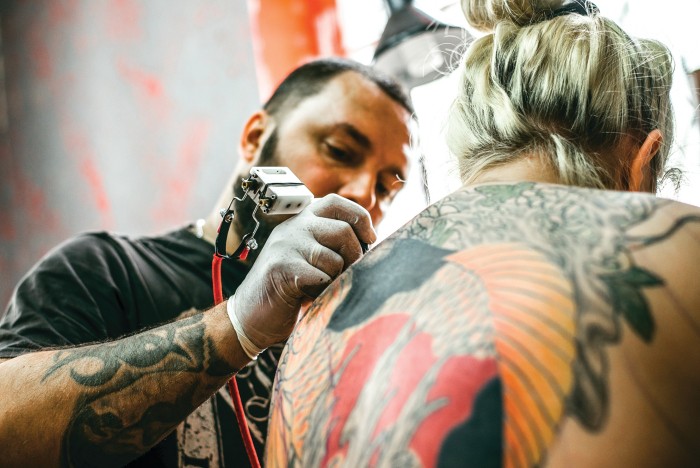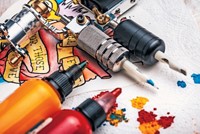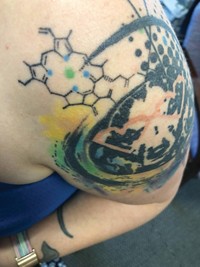Advertisement
Grab your lab coat. Let's get started
Welcome!
Welcome!
Create an account below to get 6 C&EN articles per month, receive newsletters and more - all free.
It seems this is your first time logging in online. Please enter the following information to continue.
As an ACS member you automatically get access to this site. All we need is few more details to create your reading experience.
Not you? Sign in with a different account.
Not you? Sign in with a different account.
ERROR 1
ERROR 1
ERROR 2
ERROR 2
ERROR 2
ERROR 2
ERROR 2
Password and Confirm password must match.
If you have an ACS member number, please enter it here so we can link this account to your membership. (optional)
ERROR 2
ACS values your privacy. By submitting your information, you are gaining access to C&EN and subscribing to our weekly newsletter. We use the information you provide to make your reading experience better, and we will never sell your data to third party members.
Consumer Safety
What chemicals are in your tattoo?
European regulators worry about the inks used to make body decorations, which can be repurposed from the car paint, plastics, and textile dye industries
by Sarah Everts
August 15, 2016
| A version of this story appeared in
Volume 94, Issue 33

Humans have been tattooing themselves for millennia, motivated by reasons as diverse as the designs decorating their skin. Crusaders tattooed crosses on their bodies to ensure they’d go to heaven, while for centuries, sailors inked their bodies to boast about where they’d travelled. The 61 tattoos on Ötzi, a 5,300-year-old mummy discovered in the Alps, were all located near his joints, leaving researchers to speculate that the tattoos may have been part of an ancient arthritis treatment.
These days, however, most of the 120 million tattooed people worldwide have inked themselves for fashion. This trend is on the upswing among young adults, especially women, who now possess more inked body art than men in Italy, Denmark, and the U.S., according to Darren McGarry, who led a panel discussion about tattoo science and policy at the European Science Open Forum (ESOF) conference in Manchester, England, in late July.
But if tattoos are now commonplace, knowing the ingredients and provenance of the colorful cocktail injected beneath the skin is not. It’s not widely known by the general public that the pigments found in tattoo inks can be repurposed from the textile, plastics, or car paint industry, said McGarry, who works at Joint Research Centre (JRC), which provides independent scientific advice to the European Commission.
Members of the ESOF panel voiced concern about patchy regulatory oversight of tattoo inks in the European Union and about a tattooing culture in which consumers rarely question tattoo artists about the origin of the pigments that decorate their bodies. Given these issues, they called for research on the long-term health risks of tattooing and for harmonizing regulations controlling tattoo parlors and inks across the EU.
Source: Joint Research Centre

Source: Joint Research Centre
According to a report the JRC released this year, European regulators and others are concerned that “pigments used in the formulation of tattoo and permanent make-up inks are not produced for such purpose and do not undergo any risk assessment that takes into account their injection into the human body for long-term permanence.”
The report notes that in the U.S. and Canada, policies that govern tattooing are also spotty. In those countries, the procedure is regulated at state or provincial levels, generating “a wide variety of guidelines and hygiene standards.”
Tattoo artists also have concerns. “There are certainly really good producers of ink. But some of the inks on the market weren’t intended for tattooing. They just put them in a fancy bottle, put a dragon on the bottle, and write ‘tattoo’ on it,” said Jens Bergström, who has been a tattoo artist for 20 years and owns the Heavenly Ink Tattoo & Piercing studio in Åkersberga, Sweden. “That’s how easy it is, and that’s the danger,” said Bergström, who was a panelist at ESOF.
The 118-page JRC report—which compiled surveillance, ingredient analysis, and adverse reaction data—found that tattoo and permanent makeup products containing dangerous substances or contaminated by microbes “are available on the EU market. The main risks identified, in descending order, are the presence of polycyclic aromatic hydrocarbons, primary aromatic amines, microorganisms, heavy metals, and preservatives.”
“Most consumers are aware of the infection risks, but few are aware of the chemical risks,” said Anke Meisner, a policy officer at the German Federal Ministry of Food & Agriculture and a panel member at the ESOF conference. According to the JRC report, from 2005 to 2015, chemical ingredients were the primary concern in 95% of the 126 tattoo ink cases reported to the EU’s rapid alert system for dangerous products.
Inks imported from the U.S. were responsible for two-thirds of the tattoo-related alerts sent to European authorities, the JRC report says. A further one-quarter of these problematic inks came from China, Japan, and some European countries, while the provenance of 9% of products was unknown.
According to the JRC report, the bulk of tattoo health complications involve allergic reactions and hypersensitivity, mostly in red or black areas of tattoos.

Dermatologist Jørgen Vedelskov Serup of Bispebjerg Hospital says he’s cared for 500-plus problem tattoo cases. Serup told ESOF attendees he’s seen lumpy, so-called papulonodular skin elevation from pigment overload, chronic inflammation, long-term light sensitivity and other side effects from tattooing. “As a doctor, if you do a cosmetic procedure, by law, you have to tell the patients the risks. It’s amazing that the same is not [universally] required in tattooing,” Serup said.
Tattoo inks can contain a cornucopia of compounds: Some 100 pigments and 100 additives have been found in these products, Maria Pilar Aguar Fernandez told ESOF attendees. She is responsible for the Chemicals Assessment & Testing Unit at the JRC and was involved in writing the organization’s tattoo report.
The top chemicals of concern found in tattoo inks, according to the report, are polycyclic aromatic hydrocarbons (PAHs), such as benzo[a]pyrene, which is listed as a human carcinogen by the International Agency for Research on Cancer (IARC). The report notes PAHs can migrate from the skin to lymph nodes. These problematic chemicals are found mostly in black inks and are most likely impurities from industrial production—in fact, some tattoo formulations are only between 70–90% pure, the report says. Tattoo inks may also contain potentially harmful metal impurities such as chromium, nickel, copper, and cobalt.
Tattoo pigments themselves can be health hazards. “If the ink is really bright in color, it usually contains dangerous stuff,” tattoo artist Bergström said. Fortunately, cinnabar, a mercury sulfide pigment, which was once a popular bright red in tattoo formulations, has been phased out of use.
Currently, stakeholders are more concerned about azo pigments, the organic pigments making up about 60% of the colorants in tattoo inks. Although many of these azo pigments are not of health concern while chemically intact, they can degrade with the help of bacteria or ultraviolet light into potentially cancer-causing primary aromatic amines, notes the report.
Furthermore, during tattoo removal—by some surveys up to 50% of tattoo owners come to regret their ink—lasers are often used to blast apart pigments, sending problematic degradation products into the body.
Researchers don’t know “how these degradation products are distributed in the body and how they get excreted,” Meisner said. “There’s a knowledge gap about metabolism of ingredients.”
Another problematic component of tattoo inks is the preservatives that can be added to keep microbes from growing in the often nutrient-rich solutions. In one survey of 229 tattoo inks by Swiss regulators, nearly a quarter of inks analyzed contained the antiseptic benzoisothiazolinone, which is a skin irritant. Also, 7% of inks in the study contained the preservative formaldehyde, which is classified as a carcinogen by the IARC.
The JRC report highlights the need to fund research on the toxicity of tattoo ingredients and how they degrade in the body as well as to fund the development of analytical techniques to detect and monitor impurities. “Prospective epidemiological studies would be needed to ascertain the risk of carcinogenicity from tattoo inks constituents, including their degradation products,” says the report, which also lists this as a research priority.
“We are facing a tremendous knowledge gap. This is why it is so difficult to develop regulations,” dermatologist Serup said.
Across the EU, tattoo inks are regulated under a blanket consumer product law that dictates only safe products may be placed on the market. The European Chemicals Agency is currently investigating whether tattoo ink ingredients should be subject to region-wide regulatory restrictions.
In 2008, the Council of Europe, an organization focused on promoting human rights and the integration of regulatory functions in the continent, recommended policies to ensure the safety of tattoos and permanent makeup. This document lists 62 chemicals that should not be present in tattoos and permanent makeup products. It also recommends that tattoo ink bottles should list best-before dates, batch numbers, and “the name and address of the manufacturer or the person responsible for placing the product on the market,” among other things.
Motivated by the Council of Europe’s recommendations, about one-third of EU countries, including Germany, Spain, and France, implemented a mishmash of their suggestions through national laws. For example, among other regulations, Germany has made it illegal for tattoo inks in the country to contain any chemicals on the Council of Europe’s list of substances banned in cosmetics. “What is not safe on the skin is not safe in the skin,” Germany’s Meisner said. Other EU countries have instituted licensing requirements for tattoo artists or made it illegal to tattoo without informing clients of potential health risks.
Meanwhile the JRC report points out that no information about tattoo regulations was available for Hungary, Iceland, Lithuania, and the U.K. “We have not done any market surveillance in the U.K.,” said Robert Pinchen, a U.K. market surveillance representative at the ESOF conference. “I’m very concerned about the amount of potential counterfeit inks that are on the marketplace and all these do-it-yourself kits that are available,” Pinchen added.
It’s frustrating that different countries have different rules, said Bergström, the tattoo artist. “We want harmonized rules in the whole European Union.” Until that happens, Bergström suggests that individuals getting a tattoo make informed decisions.
“Nobody gets forced to have a tattoo. So it’s in your own interest as a consumer to ask questions. If the tattoo artist can answer your questions and produce some documents regarding the ink, that’s a good thing,” Bergström said. “As a practitioner, it is my responsibility that I produce as [low a] risk as possible.”
But, he added, “Don’t just take for granted that all tattoo artists are good or all inks are good. You are also responsible for your own health.”





Join the conversation
Contact the reporter
Submit a Letter to the Editor for publication
Engage with us on Twitter